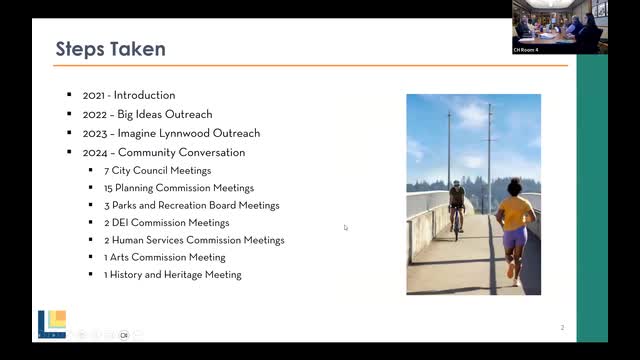City Council Considers Major Growth Plan for Lynnwood
October 21, 2024 | Lynnwood, Snohomish County, Washington
This article was created by AI summarizing key points discussed. AI makes mistakes, so for full details and context, please refer to the video of the full meeting. Please report any errors so we can fix them. Report an error »

In a recent government meeting, city officials discussed the progress and future of Lynnwood's comprehensive plan, which aims to accommodate significant population and job growth over the next two decades. The Planning Commission has recommended the approval of this plan to the city council, following a public hearing. The comprehensive plan targets a population increase of approximately 25,000 residents, bringing the total to around 63,735 by 2044. This ambitious goal includes the addition of 14,000 new dwelling units and the creation of 22,000 jobs.
Key to the plan is a focus on diverse housing options, particularly for low- to moderate-income residents. The city has identified a need for housing units that cater to various income levels, with a notable emphasis on units priced at 50-80% and 30-50% of the area median income (AMI). Interestingly, while the plan does not require specific allocations for market-rate units, Lynnwood has a substantial number of these units planned.
The meeting also highlighted the need for regulatory changes to support the anticipated growth in housing and jobs, particularly in the city’s regional growth center. The introduction of a new residential neighborhood zone is expected to facilitate the development of middle housing, aligning with recent state legislation aimed at enhancing growth management.
Council members raised questions regarding the relationship between housing density and job creation. Data presented indicated a consistent ratio of approximately 1.67 jobs per housing unit, suggesting that increases in housing do not necessarily lead to proportional job growth. This ratio has remained stable despite fluctuations in the housing market, particularly during the COVID-19 pandemic.
Additionally, the meeting addressed current vacancy rates in retail and office spaces, revealing a low retail vacancy rate of 2.5%, while office spaces showed a range of 3% to nearly 19% depending on building quality. These figures suggest a relatively healthy retail market in Lynnwood, especially when compared to larger urban centers facing higher vacancy rates.
As the city council prepares to review the comprehensive plan, officials are optimistic about Lynnwood's growth trajectory and the potential for revitalizing its urban landscape through strategic planning and community engagement.
Key to the plan is a focus on diverse housing options, particularly for low- to moderate-income residents. The city has identified a need for housing units that cater to various income levels, with a notable emphasis on units priced at 50-80% and 30-50% of the area median income (AMI). Interestingly, while the plan does not require specific allocations for market-rate units, Lynnwood has a substantial number of these units planned.
The meeting also highlighted the need for regulatory changes to support the anticipated growth in housing and jobs, particularly in the city’s regional growth center. The introduction of a new residential neighborhood zone is expected to facilitate the development of middle housing, aligning with recent state legislation aimed at enhancing growth management.
Council members raised questions regarding the relationship between housing density and job creation. Data presented indicated a consistent ratio of approximately 1.67 jobs per housing unit, suggesting that increases in housing do not necessarily lead to proportional job growth. This ratio has remained stable despite fluctuations in the housing market, particularly during the COVID-19 pandemic.
Additionally, the meeting addressed current vacancy rates in retail and office spaces, revealing a low retail vacancy rate of 2.5%, while office spaces showed a range of 3% to nearly 19% depending on building quality. These figures suggest a relatively healthy retail market in Lynnwood, especially when compared to larger urban centers facing higher vacancy rates.
As the city council prepares to review the comprehensive plan, officials are optimistic about Lynnwood's growth trajectory and the potential for revitalizing its urban landscape through strategic planning and community engagement.
View full meeting
This article is based on a recent meeting—watch the full video and explore the complete transcript for deeper insights into the discussion.
View full meeting
